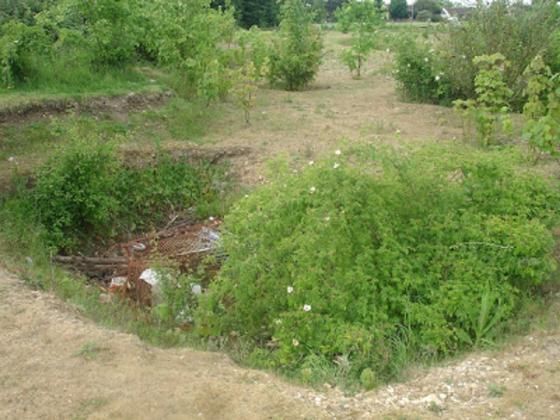
It is an extraordinary, enigmatic stone, and there must be a reason why it is embedded in the church wall.

It is an extraordinary, enigmatic stone, and there must be a reason why it is embedded in the church wall.

One of two sarsens in front of the gate of the Church of St Mary with St Leonard in Broomfield, Chelmsford.

Two sarsens outside The Church of St Mary with St Leonard in Broomfield, Chelmsford.

Puddingstone in the south wall of The Church of St Mary with St Lawrence, Broomfield, Chelmsford.

Close-up of the pudingstone in the south wall of The Church of St Mary with St Lawrence, Broomfield, Chelmsford.
The Church of St Mary with St Leonard in Broomfield, Chelmsford, Essex stands on a little knoll a couple of miles from the town centre. It is one of only six churches in the county with a round tower – the reason for constructing round towers here is that large stones are so scarce in the county that using small stones, set in mortar, was an economical way of building larger structures. The Essex RIGS Group on behalf of Essex ( essexwt.org.uk/Geology/sites2.htm ) has the following entry -
“Chelmsford. At Chelmsford Museum a block of puddingstone stands next to the main entrance door.[*] Two sarsen stones can be seen in Broomfield by the church gate.”
Following a recent visit to Alphamstone, which also has sarsens by the church gate and built into its foundations, the mention of two sarsens by the gate of The Church of St Mary with St Leonard was enough to lure me out this afternoon. Could there really be more sarsens in the stone-scarce county of Essex? After a couple of wrong turns I finally found the church and saw the two sarsens as I went past the church gate. Deciding to drive a little further I went down a lane and pulled up behind the church. Entering the churchyard from a gate on the west side I started walking clockwise around the church. Nothing to see in the foundations – nothing that is until I turned the south-east corner. There in the foundations of the south wall was this -themodernantiquarian.com/img_fullsize/68398.jpg
The stone (an amazing black puddingstone) has a similar ‘positioning’ to one of the stones protruding from the foundations at Pewsey Church in Wiltshire – it literally sticks out about two foot from the wall and is about six inches from ground level! I stood there gob-smacked for a while when the vicar happened to walk by. “Interesting stone” said I. The vicar nodded and said he thought it was either a way marker or of pagan origin. He then went on to tell me about Pope Gregory and his edicts concerning the assimilation of pagan practices into early Christianity. Although the church was locked, the vicar took me in (via the tradesman’s entrance as he put it) for a look inside. Some interesting items in there and well worth a visit. On the way out I picked up a copy of the church information pamphlet** which has this to say -
“The original Norman church, possibly on the site of a wooden Saxon church was probably built on the incentive of the de Mandeville family of Broomfield Hall, almost a thousand years ago. The south wall of that original small church containing nave and chancel survives today. The windows were small lancets then and the chancel was shorter, as can be seen from Roman bricks that formed the original south east corner. Among the flint and Roman bricks of the South wall is a projecting puddingstone, or mass conglomerate. Some believe that such marker stones are an indication of a pre-Christian site.”
The pamphlet goes on to say -
“The Roman tiles are a reminder of the story still related fifty years ago. The plan had originally been to build the church at the top of New Barn Lane, called Dragon’s Foot in the tithe maps, there is a depression, now somewhat ploughed out but still deep enough to be a dragon’s footprint. This was the site of a Roman building which still yields numerous hypocaust tiles and bricks, so the story is a delightfully muddled memory of the Saxons trundling cartloads of Roman bricks down to the Green on the orders of their new Norman masters to use as quoins since there were no local stone quarries.”
The Church of St Mary with St Leonard has all the hallmarks of a Christianised site. As at Alphamstone in Essex and Pewsey in Wiltshire it has an unusual stone protruding (and prominently visible) in its foundations. Across the lane from St Mary with St Leonard’s there is a pond (as there is at East Kennet church in Wiltshire). The pond is fed by both a stream and several springs – one of the houses (parts of which are medieval) opposite the church has a rivulet running under the paving stones in its cellar. I was told by the occupant of this house that the two sarsens in front of the church gate were originally in the stream that runs close to the church. The springs and stream, together with evidence of a Roman villa and the unusual black puddingstone in the church foundations, perhaps all indicate that the site was sacred and pre-dates both Christianity and the Roman occupation.
* See themodernantiquarian.com/img_fullsize/68397.jpg
** The Church of St Mary with St Leonard by Ann Howard.









